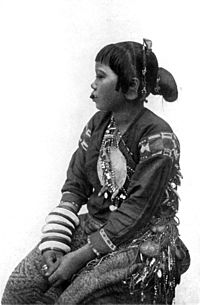Mangyan peoples

A Mangyan woman in traditional attire, c. 1912
|
|
| Regions with significant populations | |
|---|---|
|
(Mindoro) |
|
| Languages | |
| Buhid, Tawbuid, Hanunoo, Alangan, Iraya, Tadyawan, Tagalog, English | |
| Religion | |
| Animism (majority), Christianity (Predominantly Roman Catholic and Evangelical Protestant) |
Mangyan is the generic name for the eight indigenous groups found on the island of Mindoro, southwest of the island of Luzon, the Philippines, each with its own tribal name, language, and customs. The total population may be around 100,000, but official statistics are difficult to determine under the conditions of remote areas, reclusive tribal groups and some having little if any outside world contact.
The ethnic groups of the island, from north to south, are: Iraya, Alangan, Tadyawan, Tawbuid (called Batangan by lowlanders on the west of the island), Buhid, and Hanunoo. An additional group on the south coast is labelled Ratagnon. They appear to be intermarried with lowlanders. The group known on the east of Mindoro as Bangon may be a subgroup of Tawbuid, as they speak the 'western' dialect of that language. They also have a kind of poetry which is called the Ambahan.
The Mangyans were once the only inhabitants of Mindoro. Being coastal dwellers at first, they have moved inland and into the mountains to avoid the influx and influence of foreign settlers such as the Tagalogs, the Spanish and their conquests and religious conversion, and raids by the Moro (they raided Spanish settlements for religious purposes, and to satisfy the demand for slave labor). Today, the Mangyans live secludedly in remote parts of Mindoro but eventually comes down to the lowlands in order to make usual trades. Their sustenance are farming for their own crops, fruits, and hunting. A certain group of Mangyans living in Southern Mindoro call themselves Hanunuo Mangyans, meaning “true”, “pure” or “genuine,” a term that they use to stress the fact that they are strict in the sense of ancestral preservation of tradition and practices.
Before the Spaniards arrived in Mindoro, the people traded with the Chinese extensively, with thousands of supporting archaeological evidences found in Puerto Galera and in written Chinese references. A division was created among the people of Mindoro when the Spaniards came. There were the Iraya Mangyans, who isolated themselves from the culture of the Spaniards, and the lowland Christians who submitted themselves to a new belief system. These two groups only interacted for economic matters through trading forest goods from the Mangyan and consumer goods for the lowlanders.
Despite being grouped as one tribe, Mangyans differ in many ways. In comparison to the technological advance between the two geographical divisions, the Southern tribes are more advanced as seen in their use of weaving, pottery and system of writing. The Northern tribes, on the other hand, are simpler in their way of living. Their language, as in the rest of the Philippines, came from the Austronesian language family. However, even if they are defined as one ethnic group, the tribes used different languages. On the average, they only share 40% of their vocabulary. The tribes have also varied physical and ethnogenetic appearances: Iraya has Veddoid features; Tadyawan are mainly Mongoloid; and the Hanunuo looks like a Proto-Malayan.
...
Wikipedia
